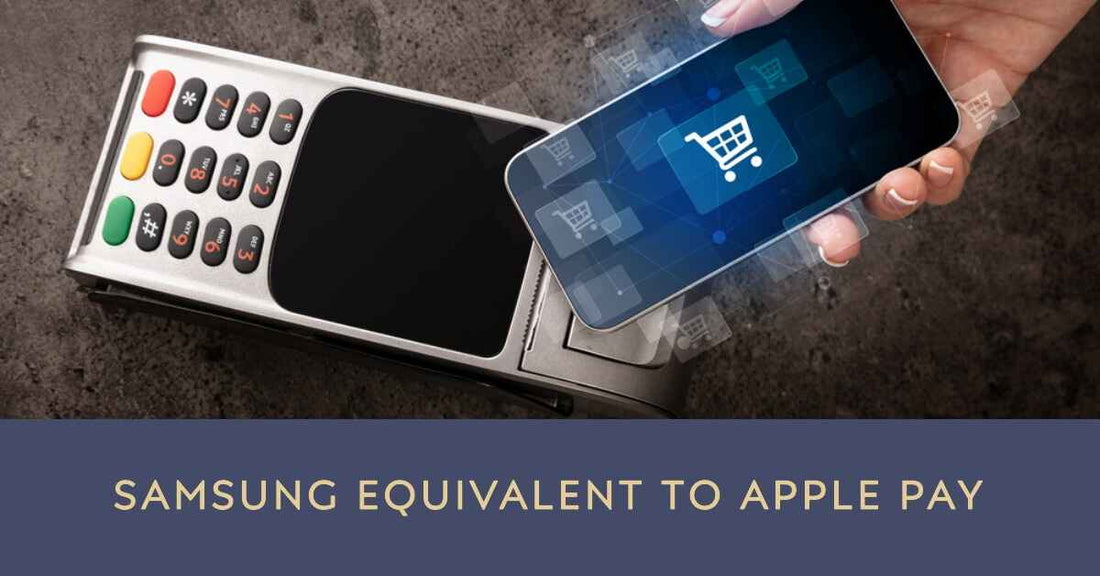
Samsung Equivalent to Apple Pay
Share
Samsung Equivalent to Apple Pay
A Comprehensive Samsung Apple Pay Guide
Samsung Equivalent to Apple Pay. Looking for a fresh twist to your digital wallet experience? Samsung has tossed its hat into the ring.
We're about to crack open the details of Samsung's intriguing alternative to Apple Wallet.
It's more than just a tool - it's a streamlined strategy for handling your day-to-day transactions, offering a unique blend of security and convenience. This guide will illuminate:
- The nuts and bolts of setting up and using Samsung's digital wallet
- The secret sauce - features that give Samsung's offering an edge over Apple Wallet
- Everyday scenarios where Samsung's digital wallet triumphs
Ready for a deep dive into a world where Samsung squares off against Apple in the digital wallet arena?
The adventure begins right here.
What's the Buzz About Digital Wallets?
Imagine replacing that stuffed physical wallet with a digital one. Cool, isn't it? Digital wallets are these handy apps that securely tuck away your payment information, making shopping a breeze.
They can help you track expenses and even store other types of cards and documents digitally. Say goodbye to lost loyalty cards and hello to convenience.
Samsung Equivalent to Apple Wallet? - Meet Samsung Pay
Samsung's response to Apple Pay comes in the form of Samsung Pay, a mobile wallet platform exclusive to Samsung phone users.
Samsung Pay, much like Apple Pay, centralises your credit and debit cards, loyalty cards, and digital IDs for convenience.
What sets Samsung Pay apart from other digital wallets, such as Apple Pay and Google Pay is Samsung Pass.
This unique feature allows users to access their Samsung account and apps using biometric data, such as a fingerprint or iris scan, adding an extra layer of security to their financial and payment information.
Beyond cards, Samsung Pay also stores digital keys, including digital car keys and boarding passes.
And, with Samsung Pass, users can securely store passwords for third-party apps, event tickets, and ID cards. If your phone is lost, Samsung Pay can be remotely locked or wiped, ensuring your data's safety.
Using Samsung Pay for contactless payments is straightforward: swipe up from the app drawer and authenticate with Touch ID, Face ID, or a PIN.
This feature, along with many others, makes Samsung Pay an attractive alternative to Apple Pay for Samsung phone users.
Setting Up Samsung Pay: A Walkthrough for Your Digital Wallet Journey
Embarking on the adventure of setting up Samsung Pay? Don't worry, we've got you covered. This handy digital wallet not only modernises your payment methods but also simplifies your shopping experiences.
Here's a step-by-step guide to setting up Samsung Pay:
-
Grab Your Samsung Device: Samsung Pay is exclusive to Samsung devices. If you don't have one yet, explore some of the best Samsung refurbished phone deals to get started.
-
Download Samsung Pay: You can find the Samsung Pay app on the Google Play Store or it may come pre-installed on your Samsung device. If it's already installed, make sure you have the latest version by checking for updates.
-
Launch the App: Open Samsung Pay. You'll be greeted with a brief introduction about the app. Swipe through and tap "Start".
-
Sign in to Your Samsung Account: You'll need a Samsung account to use Samsung Pay. If you don't have one, it's easy to create. Just follow the prompts.
-
Secure Your Account: Security is paramount in digital transactions. Samsung Pay uses a PIN, fingerprint, or iris scanner for authentication. Set up the one you prefer.
-
Add Your Card: Now, you can add your credit, debit, or loyalty cards. Tap on 'Add card', then use your camera to auto-read card details, or enter them manually.
-
Verify Your Card: Depending on your bank, you might need to verify your card through a text message, email, or a call to your bank.
-
Start Paying: You're all set! You can now use Samsung Pay at your favourite stores. Just swipe up from your home screen, select your card, authenticate, and tap your phone to the payment terminal.
Remember, Samsung Pay isn't just about making payments. With features like Samsung Pass, it also securely stores your passwords, digital keys, and boarding passes.
Plus, in case your phone is lost or stolen, you can easily lock or wipe your Samsung Pay remotely, ensuring the safety of your data.
Comparing Digital Wallets: Samsung Pay vs Apple Pay
When it comes to digital wallets, two of the most popular options are Samsung Pay and Apple Pay.
While both offer unique features, they also come with their own set of pros and cons.
Let's break it down:
Samsung Pay: Versatility and MST Support
Samsung Pay distinguishes itself with several key features:
-
MST Payments: Unlike most other digital wallets, Samsung Pay supports Magnetic Secure Transmission (MST) payments, broadening the number of terminals where it can be used.
-
Digital Key and Crypto Support: Samsung Wallet, which comes integrated with Samsung Pay, can hold digital keys and even cryptocurrency.
-
Card Capacity: Samsung Pay can store up to 10 credit or debit cards, gift cards, and even some forms of ID.
-
Visa Checkout: Samsung Pay can be used at online merchants that support Visa Checkout.
However, there are a few downsides to consider:
-
Device Limitation: Samsung Pay is exclusive to Samsung devices.
-
Limited Peer-to-Peer Payments: Samsung Pay does not support the sending and receiving of funds via peer-to-peer payments.
-
Bank Support: Far fewer banks support Samsung Pay compared to its rival, Apple Pay.
Apple Pay: Security and Broad Compatibility
Apple Pay also offers some unique advantages:
-
Enhanced Security: With Touch ID and Face ID authentication, Apple Pay takes security to the next level.
-
Broad Compatibility: Apple Pay is supported across various Apple devices, thanks to watchOS and macOS support. It can even be used without an internet connection.
-
Bank Support: Apple Pay is supported by a much larger number of financial institutions compared to Samsung Pay.
Nevertheless, it's not without its drawbacks:
-
No MST Payments: Unlike Samsung Pay, Apple Pay doesn't support MST payments, which can limit the number of payment terminals it can be used with.
-
Limited Peer-to-Peer Payments: Peer-to-peer payments can only take place between Apple users.
-
Card Capacity: Depending on the operating system version, Apple Pay may only allow for up to 8 cards.
-
Setup Process: Some users may find the process to set up and authorise cards somewhat complex.
In conclusion, the choice between Samsung Pay and Apple Pay largely depends on your personal needs and the device you use.
Both have their strengths and weaknesses, so it's essential to consider what aspects are most important to you before making your choice.
What Does Samsung Have Similar to Apple Wallet? - Final Thoughts
In the digital age, Samsung Pay and Apple Wallet are game-changers, transforming our daily transactions and personal item management.
These wallet apps, along with other mobile wallet platforms like Google Pay, are revolutionizing the way we use credit and debit cards, loyalty cards, and even digital IDs.
If you're an Android phone user eyeing the Samsung Wallet app, or an Apple Watch user curious about Apple Pay, but are mindful of the cost, UR.co.uk offers excellent deals on Refurbished Samsung handsets and affordable refurbished iPhones.
With Samsung Wallet, Samsung phone users can enjoy features like Samsung Pass, which can store digital keys and boarding passes, making life more convenient.
Apple Wallet and Google Wallet offer similar convenience, making payment cards digital and even replacing physical car keys with digital car keys.
In a world where digital wallet apps are becoming the norm, there's no better time to join the revolution.
So, why wait? Start your digital wallet journey today, and remember - your Samsung account or Apple ID is your key to this exciting digital world.
FAQs
How does Samsung Pay compare to Apple Pay in terms of unique features?
Samsung Pay supports MST payments, digital keys, and even cryptocurrency. It also has a higher card capacity compared to Apple Pay.
However, it has its limitations, such as being exclusive to Samsung devices and having less support from banks compared to Apple Pay.
2. What is Samsung Pass and how does it enhance Samsung Pay?
Samsung Pass is a unique feature of Samsung Pay that allows users to access their Samsung account and apps using biometric data. This adds an extra layer of security to their financial and payment information.
To know more about how to securely handle your Samsung phone, you can learn how to turn off your Samsung S21 or how to unlock a Samsung phone.
3. Can Samsung Pay be used for online purchases?
Yes, Samsung Pay can be used for online purchases. This is a feature that gives Samsung Pay an edge over other digital wallets.
With Samsung Pay, users can checkout from online stores in a fast and secure manner, simplifying the purchasing process.
For optimal performance of your Samsung device during such transactions, you may want to learn how to clear cache on your Samsung device.
What can I do if my phone with Samsung Pay is lost or stolen?
If your phone is lost or stolen, Samsung Pay can be remotely locked or wiped to ensure the safety of your data. This remote feature is part of Samsung's commitment to maintaining the security of its users' personal and financial information. For more tips on how to handle your Samsung device, check out how to back up your Samsung phone.
How does Samsung Pay handle contactless payments?
To use Samsung Pay for contactless payments, you simply swipe up from the app drawer and authenticate with Touch ID, Face ID, or a PIN. This straightforward process allows for quick and convenient transactions.




